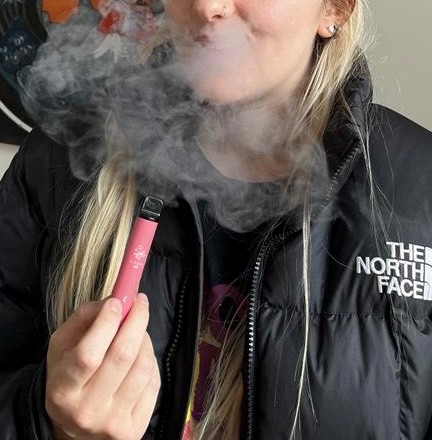Health experts warn of vaping, nicotine addictions in reaction to vaping surge

An unidentified CSU Sacramento student vaping on campus. Photo by Juliana Castro, C.K. McClatchy High.
October 2, 2022
The teen vaping surge has skyrocketed recently because e-cigarette companies like Juul Labs target younger audiences, according to the U.S Food and Drug Administration (FDA).
Sutter Health Respiratory Practitioner Aisha Perez said, “Do not get involved in any recreational vices like vaping, smoking, any drugs or pills because the younger you start the earlier you will get sick. We see people who have been smoking since they were 12 or 13 years old and by the time they’re about 35 to 37 years old they are looking like they are in their 50s.”
Vapes and e-cigarettes contain nicotine, which is a highly addictive and dangerous chemical. According to the Centers for Disease Control and Prevention (CDC), both smoking and vaping cause severe heart and lung disease that can lead to death. Life expectancy for smokers is 10 years shorter than for non-smokers.
“Some smokers have to have very intense procedures to clean out their lungs because sometimes they get cavitary lesions or they get these pockets where puss tends to accumulate,” said Perez. “There is really no way to get them out without doing a video-assisted thoracoscopic surgery (VATS) procedure.”
She said some smokers “get really sick to the point where they are on a mechanical ventilator and require high levels of intervention to get them off or to clean out the accumulation of stuff that collects in the lungs.”
Perez added, “Anytime you smoke, the cilia (in your lungs) that help expel anything that is an irritant to your lungs, smoking kills all of that. That is why when smokers get sick they have a long-lasting cough because they don’t have the properties in their lungs to be able to clear it as much as a non-smoker. If we do see them because they have been vaping, we do see them with quite extensive injuries in the ICU a lot.”
The news media reported on Sept. 6 that Juul has to pay $438.5 million in a settlement after an investigation discovered that the company intentionally advertised its products to adolescents, even though e-cigarette sales to children are illegal.
The settlement with 34 states and Puerto Rico will be paid off in six to 10 years. In addition to the monetary payments to the states, the settlement prohibits the firm from marketing to minors or funding consumer education programs.
Several states, including California, have filed separate lawsuits against Juul and are not part of the settlement.
Perez said, “We have had a couple of teenagers in our pediatric ICU on mechanical ventilators due to vaping injuries.”
Aura Soerianata, a senior at McClatchy High School who vapes, said, “The lawsuit against Juul is well deserved, yet not done faster. At this point, millions of vape brands are marketing to the same audience, too much to keep under control. The advertisements for drugs are getting too commercialized thus enticing a much younger audience.”
A big reason why students get into drugs, vapes, and cigarettes is because of their environment and peer pressure, Soerianata said, “I first tried a vape in my freshman year of high school. I tried it in the rush of the moment, a friend offered it and I’d seen it being used by kids my age so I was curious.”
Although she is aware of the health risks, and has experienced a time when she would vape almost every day and noticed she got out of breath easier and wasn’t as hungry, Soerianata said she will continue to use it until she notices a significant difference in her health.
“I keep myself from getting addicted by only vaping in social gatherings. I think I could be doing something more productive in my free time than vaping,” she said.

Leo Her • Apr 25, 2023 at 7:56 pm
where can I get your email, to contact you on some info for my senior project on asking a expert about our topic and mines about vaped which we both match.